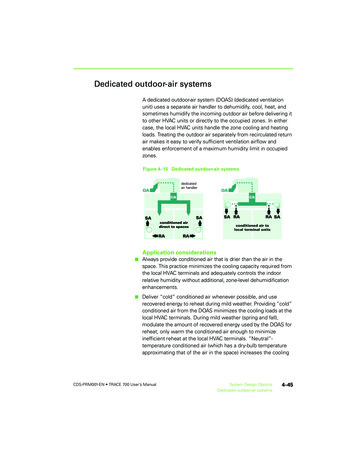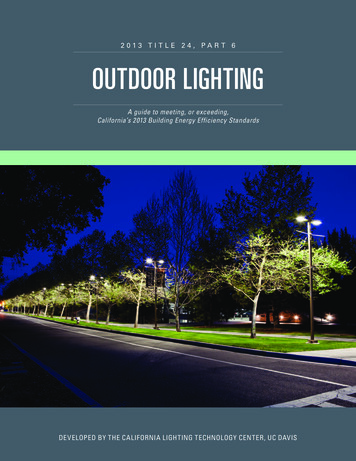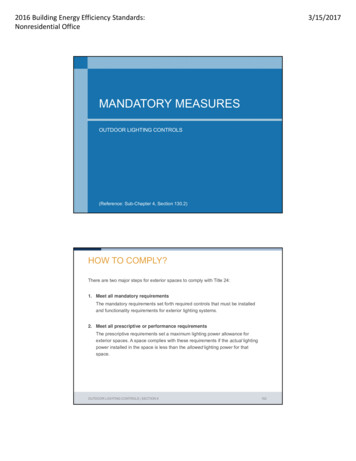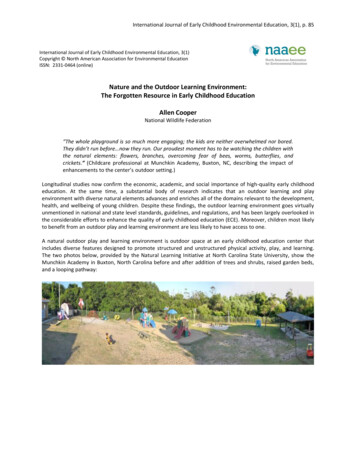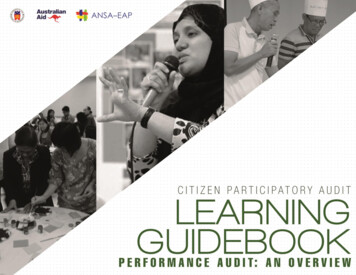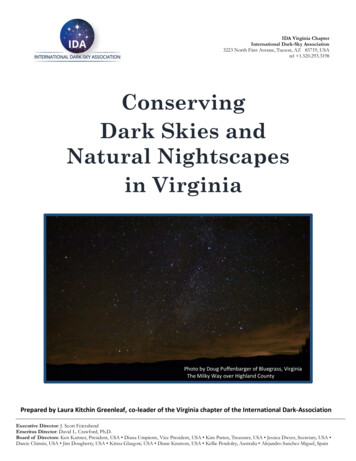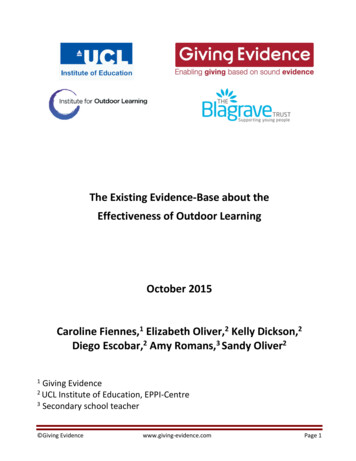
Transcription
The Existing Evidence-Base about theEffectiveness of Outdoor LearningOctober 2015Caroline Fiennes,1 Elizabeth Oliver,2 Kelly Dickson,2Diego Escobar,2 Amy Romans,3 Sandy Oliver21Giving Evidence2 UCL Institute of Education, EPPI-Centre3 Secondary school teacher Giving Evidencewww.giving-evidence.comPage 1
About The AuthorsGiving Evidence is a consultancy and campaign, promoting charitable giving based on sound evidence.Through consultancy, Giving Evidence helps donors and charities in many countries to understand theirimpact and to raise it. Through campaigning, thought-leadership and meta-research, we show what evidenceis available and what remains needed, what it says, and where the quality and infrastructure of evidenceneed improving.Giving Evidence was founded by Caroline Fiennes, a former award-winning charity CEO, and author of It Ain’tWhat You Give. Caroline speaks and writes extensively about these issues, e.g., in the Stanford SocialInnovation Review, Freakonomics, and the Daily Mail. She is on boards of The Cochrane Collaboration,Charity Navigator (the world’s largest charity ratings agency) and the US Center for Effective Philanthropy.The Evidence for Policy and Practice Information and Co-ordinating Centre (EPPI-Centre) is part of the SocialScience Research Unit (SSRU), UCL Institute of Education, University College London.The EPPI-Centre was established in 1993 to address the need for a systematic approach to the organisationand review of evidence-based work on social interventions. The work and publications of the Centre engagehealth and education policy makers, practitioners and service users in discussions about how researchers canmake their work more relevant and how to use research findings.Founded in 1990, the Social Science Research Unit (SSRU) is based at the UCL Institute of Education,University College London. Our mission is to engage in and otherwise promote rigorous, ethical andparticipative social research as well as to support evidence-informed public policy and practice across a rangeof domains including education, health and welfare, guided by a concern for human rights, social justice andthe development of human potential.***This work was a team effort involving: designing, co-ordinating and publicizing the study and drafting thereport (CF, SO), designing and implementing the search strategy (KD), retrieving reports (DE), coding andanalyzing systematic reviews (LO) and UK primary studies (DE, SO), and drawing out implications for schoolsand study centres (AR). All authors approved the final report.The views expressed in this work are those of the authors and do not necessarily reflect the views of theEPPI-Centre or the funder. All errors and omissions remain those of the authors.The study was guided by a Steering Group1 drawn from the outdoor learning sector, and we are grateful tothem for their input. It was conducted from April to September 2015.Contact:Caroline Fiennes, Director, Giving Evidence 44 7803 954512, caroline.fiennes@giving-evidence.com1This comprised: Andy Robinson (Chief Executive, the Institute for Outdoor Learning) – Chair; Jo Wells (Director,Blagrave Trust); Lucy Maynard (Head of Research, Brathay); Mike King (Releasing Potential and trustee of the Institutefor Outdoor Learning); Justin Dillon (Bristol University and trustee of the Council for Learning Outside the Classroom);Emma Ferris (Head of Impact Evaluation, Outward Bound); Lyndsey Nassim (Head of Sales & Marketing, Scouts) Giving Evidencewww.giving-evidence.comPage 2
Table of ContentsSummary . 5Summary of findings . 5Recommendations . 8Introduction . 91. Outdoor learning in the UK .11Scale of outdoor learning in the UK .11Nature of outdoor learning in the UK .122.International research about outdoor learning activity .12Focus of international research about outdoor learning .12Outdoor learning research addressing effectiveness .13Scope of the systematic reviews .143.Insights on the effectiveness of various outdoor learning interventions .17Headline findings .17Other findings .17How dramatic is the effect on young people? .19Does the effect on the young people endure? .194.Outdoor learning research in the UK .20Volume of the UK primary studies .20Focus of the UK primary studies .21Curriculum .21Setting .22Outcomes measured in UK primary studies .23Discussion about the coverage and focus of the existing research .265.UK primary studies contributing to the development and evaluation of interventions .27Project model and evaluation plan (Level One) .29Indication of impact (Level Two) .30Evidence of impact (Level Three) .30Model evidence and system ready (Levels Four and Five) .306.Discussion.32Implications for practice, and for funding practice .32Implications for research and the sector more widely .32Categorising types of activity .32Assessing the amount of the various types of activity .32Practitioners’ clarity about their operational models .32Prioritising research topics to create a sector-wide research agenda .34“Ask an important question and answer it reliably”.357.Conclusion and summary of recommendations .36 Giving Evidencewww.giving-evidence.comPage 3
References .37Journal analysis .37UK surveys.37Systematic reviews .37UK primary studies .38Other references .42Appendices.43Appendix 1: Composition of Steering Group .43Appendix 2: Scope and methods .44Appendix 3: Search strategy .45Appendix 4: Electronic search strategy.46Appendix 5: Numbers of studies identified .48Appendix 6: Outdoor learning activity of interest to the sector .49Appendix 7: Coding tool for describing outdoor learning in this study .51Appendix 8: The systematic reviews of the effects of outdoor learning .57Appendix 9: Characteristics of systematic reviews .58Appendix 10: Project Oracle standards of evidence in detail .64Appendix 11: Report on included systematic reviews .66Appendix 12: RCTs can be cheap, easy and quick.73 Giving Evidencewww.giving-evidence.comPage 4
SummaryEducation programmes vary in their effectiveness. Mindful of this, the Blagrave Trust, whose areas includeoutdoor learning, wanted to understand what is known about the effectiveness of the various types ofoutdoor learning programmes. In partnership with the Institute of Outdoor Learning, the Blagrave Trustcommissioned Giving Evidence and The Evidence for Policy and Practice Information and Co-ordinatingCentre (EPPI-Centre) at UCL Institute of Education to produce a systematic review of the existing literatureabout outdoor learning.By searching the academic literature systematically, and inviting submissions of research (‘crowdsourcing’)from outdoor learning organisations, we aimed to:1. Categorise the various outdoor learning (OL) activities being run in the UK, in order to provide acoherent sense of the sector as a whole;2. Identify the various outcomes which organisations running outdoor learning activities are measuring,i.e., identify the outcomes which providers seem to be seeking to achieve; and3. Assess the designs of individual evaluations (while aware that study designs vary in their openness tobias and hence inaccuracy) and the standard of evidence generally available for different types ofoutdoor learning.This review benefited from a knowledgeable Steering Group with members drawn from provider andresearch organisations. It employed a systematic search of the academic literature and crowdsourcing of UKstudies.Summary of findingsWe found that:1. A sense of the sector as a whole: There is no comprehensive or regular (repeated) survey of thescale of outdoor learning in the UK. There are some studies of specific outdoor learning activities(e.g., of particular types, or in particular parts of the UK). In these, some authors express concernabout barriers to delivering outdoor learning and a reduction in outdoor learning.2. The current research base:-Crowdsourcing UK research revealed an enthusiasm for research and sharing of knowledge amongstpeople who deliver outdoor learning activities. However, some of the material submitted were dataor reflections which included named individuals, rather than anonymized research reports. Thisraises some issues around practitioners’ understanding of research ethics.-There is a growing body of individual studies and systematic reviews about the development andeffectiveness of outdoor learning. We found 15 systematic reviews of the effects of outdoor learning.They provide extensive evidence of the effects of outdoor learning. However, the set is somewhatconfusing because many of them overlap in terms of the primary studies they include. Moreover, Giving Evidencewww.giving-evidence.comPage 5
some systematic reviews include other systematic reviews, or are an update of an earlier review. Thisoverlap therefore repeatedly reports the same evidence without necessarily strengthening it.-Distinctions between types of interventions and outcomes employed to categorise studies are notalways clear. For instance, ‘healthy lifestyles’ and ‘health and well-being’ were part of the ‘learningand development’ domain, while ‘health behaviour’ and ‘health, physical / mental’ were part of the‘health’ domain.-We found 58 primary UK studies. Four features of them are striking:a. They are spread thinly across many populations (types and age groups), interventions,settings and outcomes, such that few topics have been researched more than a handful oftimes. This leads to our suggestion that the sector collectively identify and prioritise theimportant unanswered questions, and then focuses its (presumably limited) researchresources on those priority questions.b. The activities and participants on which studies focus may not be where the sector wouldchoose that research should focus. For example, the most common study topics are:adventure or residential activity; 11-14 year olds; and the general population. This leavesvery few studies on (and hence little insight about) other age groups, popular activity such asScouts or Ramblers, or people who are not in employment, education or training (NEET),have disabilities or are post-trauma.c. That there seems surprisingly little linkage between the outcomes measured by the studiesand the agenda of ‘customers’ and funders. The outcomes measured are mainly around‘character development-type’ outcomes (communication skills, teamwork, self-confidenceetc. Very few studies addressed interventions with strong links to core curriculum subjects.There was only one primary study of educational outcomes at Key Stage 1 (5-7 year olds),few of educational outcomes at Key Stages 2, 3 and 4, and none at or beyond Key Stage 5(sixth form). There is also a mismatch with the interests of employers: ‘employability’ is onlymeasured in relation to offenders but not young people generally. Looking internationally,only six of the 15 systematic reviews looked at educational attainment, and only oneaddressed employability.d. Safety is little covered in the systematic reviews and was not measured as an outcome inany of the primary studies. Safety is obviously a major issue in outdoor learning since it canbe dangerous: few social interventions can result in broken limbs or fatalities. Even if safetyisn’t the primary focus of a study, data could be gathered about safety: this is often howpatient safety data and insights are gathered in medical research. Giving Evidencewww.giving-evidence.comPage 6
3. Outcomes assessed: This evidence, both in the UK and internationally, and in both primary studiesand systematic reviews, is very varied in terms of the populations who are offered outdoor learning,the type of outdoor learning and the outcomes assessed. The categorisation that informed this studycaptured some interventions and outcomes, but others emerged from the literature. Generally,there is considerable consensus in the general aims of interventions, but little consensus on theoutcomes for assessing their effects.4. The designs of individual evaluations:-We compared reports of UK studies in terms of attributes on a scale developed by Project Oracle,which looks at the extent of plans for an intervention and the evidence for it (described further in thedocument). Using this scale was challenging because the Project Oracle scale was designed fororganisations to plan and assess their own interventions and evaluations, rather than to assessresearch reported elsewhere.-Many UK studies did not reach Level One of the Project Oracle scale, normally because they did notcite or appear to use a Theory of Change (also known as a logic model: an articulation of the inputs,the intended outcomes, how the inputs are meant to produce those outcomes, and assumptionsabout context, participants or other conditions). Clear theories of change serve a couple of usefulpurposes: first, they demonstrate that the practitioners understand their intervention; and second,they are invaluable for other practitioners reading the research in estimating whether they willachieve the same outcomes with those interventions in their contexts. To be clear, a practitionermay have a theory of change but not cite it in their research, but (a) citing it in the research is usefuland (b) experience from many other social sectors suggests that practitioners may need support todevelop or articulate their theories of change.-No UK study, or set of studies, featured the more demanding attributes of Levels Four or Five,around the intervention having been replicated in several places.Implications for practice and policyThe study did not set out to look at implications of the research for practice and policy. Nonetheless, wefound:-Almost all outdoor learning interventions have a positive effect.-The effect attenuates over time: the effect as measured immediately after the intervention isstronger than in follow-up measures after a few months. This is common for social interventions.However, one meta-analysis found that effects relating to self-control were high and were normallymaintained over time.-Evidence for the value of longer interventions. The systematic reviews found that overnight andmulti-day activities had a stronger effect than shorter ones. While this is perhaps unsurprising, itdoes pose a challenge for funders / funding since it obviously forces a trade-off with the number ofparticipants. Giving Evidencewww.giving-evidence.comPage 7
RecommendationsFor providers of outdoor learningOutdoor learning organisations can refer to systematic reviews of research about outdoor learning whenplanning their programmes. Careful reading is required to (a) check the rigour of each review and the studiesthey include (for instance, did the review include a systematic search and critical appraisal of the studiesincluded?); and (b) check the precise types of programmes, populations and outcomes they studied.Implications for the outdoor learning sector about developing its researchBecause the existing research is spread quite thinly, few questions about effectiveness are yet answeredreliably. We therefore recommend that the outdoor learning sector collectively prioritise the variousunanswered questions in order to focus its research resources on those which are most important.We recommend that the outdoor learning sector:1. Types and volume of activity: Pull together the various data sources on this to give the currentpicture, and create a system to regularly capture data on the types and volumes of activity.2. Improve practitioners’ theories of change, enabling practitioners’ to both create and to use them.Theories of change are explained in Box 4: they are invaluable for understanding why an interventionworks and hence whether it is likely to work in other contexts, but only few evaluations of UKoutdoor learning activity cited them.3. Convene practitioners, researchers and others to prioritise research topics.4. Manage the resulting sector-wide research agenda, through relationships with funders, and possiblyby creating partnerships between practitioners and researchers.5. Ensure that both interventions and research are described clearly, fully and publicly.These recommendations are discussed more in Section 6.Outdoor learning organisations need to have systems in place to support ethical practices for monitoring andresearch, particularly the storage and sharing of data from evaluations.Greater consensus about the important outcomes of interest would allow research findings from differentstudies to be pooled more easily, and thereby facilitate accumulating knowledge to inform better the wholefield. Giving Evidencewww.giving-evidence.comPage 8
IntroductionProfessions and charities working for the public good have much to gain from sharing research about theissues they address, their efforts and achievements. The past 35 years has seen a growing emphasis onconducting research, and sharing and using the findings for improving, in particular, health, education andenvironmental conservation. Where these areas overlap is where many public, charitable and commercialservices offer opportunities for outdoor learning.The Blagrave Trust, which funds outdoor learning, recognised the value of underpinning outdoor learningwith sound research and so commissioned this project to assess the nature and scale of research available toinform outdoor learning in the UK. The Trust, together with the Institute for Outdoor Learning, wanted tohave a coherent picture of outdoor learning activities across the UK, and how they are being evaluated.Giving Evidence, which works to enable charitable giving and charitable activity to be based on soundevidence, and the EPPI-Centre at University College London, which is committed to informing policy andprofessional practice with sound evidence, joined forces to provide this picture.We made three important assumptions. First, that outdoor learning in the UK can be informed by researchconducted outside as well as inside the UK, where contexts and activities are similar. Second, that researchfor informing outdoor learning comes from both organisations that specialise in research, such asuniversities, as well as organisations that specialise in delivering outdoor learning programmes. Third, thatdeveloping and evaluating outdoor learning suits the stepwise process recommended by Project Oracle2which is being increasingly adopted for youth development. Project Oracle’s scale ‘rates’ what we knowabout interventions on whether there are: (1) detailed project descriptions and logic models; (2) before andafter studies; (3) evaluations with a control group, which one would expect for interventions beyond the pilotstage; (4) replicated evaluations of impact; and (5) multiple independent evaluations in different settings,which may imply that further evaluations are less useful.With these assumptions in mind, we searched sources of international research and invited UK outdoorlearning organisations to contribute their own research. In doing this we aimed to:1. Categorise the various outdoor learning (OL) activities being run in the UK, in order to provide acoherent sense of the sector as a whole;2. Identify the various outcomes which organisations running outdoor learning activities are measuring,i.e., identify the outcomes which providers seem to be seeking to achieve; and2“Project Oracle is a children and youth evidence hub that aims to improve outcomes for young people in London. Wedo this by building the capacity of providers and funders to develop and commission evidence-based projects, creatingan ecosystem in which evidence is widely gathered, used and shared. We also work with specific "cohorts" or sub-setsof the sector to embed good practice, and at a national and international level to promote the wider use of evaluationand evidence. Project Oracle is funded by the Greater London Authority (GLA), the Mayor’s Office for Police and Crime(MOPAC) and the Economic and Social Research Council (ESRC).” Giving Evidencewww.giving-evidence.comPage 9
3. Assess the designs of individual studies for what knowledge they can contribute about thedevelopment and evaluation of interventions in terms of the Project Oracle scale.Our precise scope and the details of how we did this are described in Appendix 2. Here we describe what wefound in terms of:oOutdoor learning activity in the UKoOverview of the international research about outdoor learningoThe effectiveness of various outdoor learning activitiesoCoverage, design and findings of the primary research of activity in the UK.We then discuss the implications for practice, policy, and guiding future research. Giving Evidencewww.giving-evidence.comPage 10
1. Outdoor learning in the UKThe diversity and scale of outdoor learning in the UK, being an overlapping patchwork of interests that differin what is offered, to whom and where, is not captured by a single, unifying survey of activities. However,there are sources of information about various types of outdoor learning offered to different populations.Scale of outdoor learning in the UKThe scale of outdoor learning was investigated by several surveys by different authors which spanned thepast 45 years, three published since 2003, and an analysis of 13 UK surveys published between 1963 and2009 (Lock 2010).Historical data (1970 – 2000) and a survey (2002) of biology and geography teachers visiting one of 17 FieldStudy Centres (FSCs) (Tilling 2004) revealed geography having ten times the amount of fieldwork at KeyStage3 4 as biology, and a decline in the proportion of biology groups using the FSCs; more specifically therewas a 6% fall between 1998 and 2003. The factors most commonly identified by biology teachers werecurriculum pressure, cost of courses, timetabling problems and a reduction in fieldwork opportunities in thecurriculum.Glackin (2007 and 2012) reports on a 2006 survey of how often south London secondary schools use localgreen spaces and parks for teaching science. Fewer than half the schools reported using fieldwork inteaching science; and only one school provided a residential science fieldtrip for either Key Stage 3 or 4.Frequent reasons for fieldtrips having a low priority were time, access to local sites, limitations of theNational Curriculum, funding and safety.When surveying fieldwork and outdoor visits and activities, but not the more local school grounds andcommunity projects, Taylor et al. (2009) found an uneven distribution of school provision and local authoritysupport for out-of-school learning at Key Stages 3 and 4 (high school). They drew on research from twoprojects: one investigating the availability of local authority outdoor education centres across England, andthe other looking at the participation in out-of-school learning within secondary schools across the UK.Most recent was Lock’s (2010) investigation of the amount and type of biology fieldwork opportunitiesavailable to pre- and post-16 students (Key Stage 5) in the UK between 1963 and 2009. Thirteen pre-existingstudies of the general school population were analysed.Lock’s (2010) findings suggest that there was a decline in biology fieldwork provision during the periodstudied, though there was not clear evidence that the number of habitats studied declined with this.Variability within the data-sets created difficulty in determining whether residential study had declined butthe evidence from the Field Studies Council (FSC) strongly suggested this was the case over the last 30 years.3UK education is divided into: Key Stage 1 (Years 1 and 2, when pupils are aged 5-7); Key Stage 2 (Years 3-6, when pupilsare aged 7-11); Key Stage 3 (Years 7-9, when pupils are aged 11-14); Key Stage 4 (Years 9-11, when pupils are aged 1416); and Key Stage 5 (years 12-13, when pupils are aged 16-18). Giving Evidencewww.giving-evidence.comPage 11
Lock (2010) concluded that there were eight factors related to the decline in fieldwork in the UK. Time andcost were the most strongly evidences factors. The more recent included studies cited the curriculum(syllabus, specification, scheme of work) and its assessment to be definitive negative factors. Lock (2010)reported that health and safety factors, teachers’ enthusiasm and teac
scale of outdoor learning in the UK. There are some studies of specific outdoor learning activities (e.g., of particular types, or in particular parts of the UK). In these, some authors express concern about barriers to delivering outdoor learning and a reduction in
